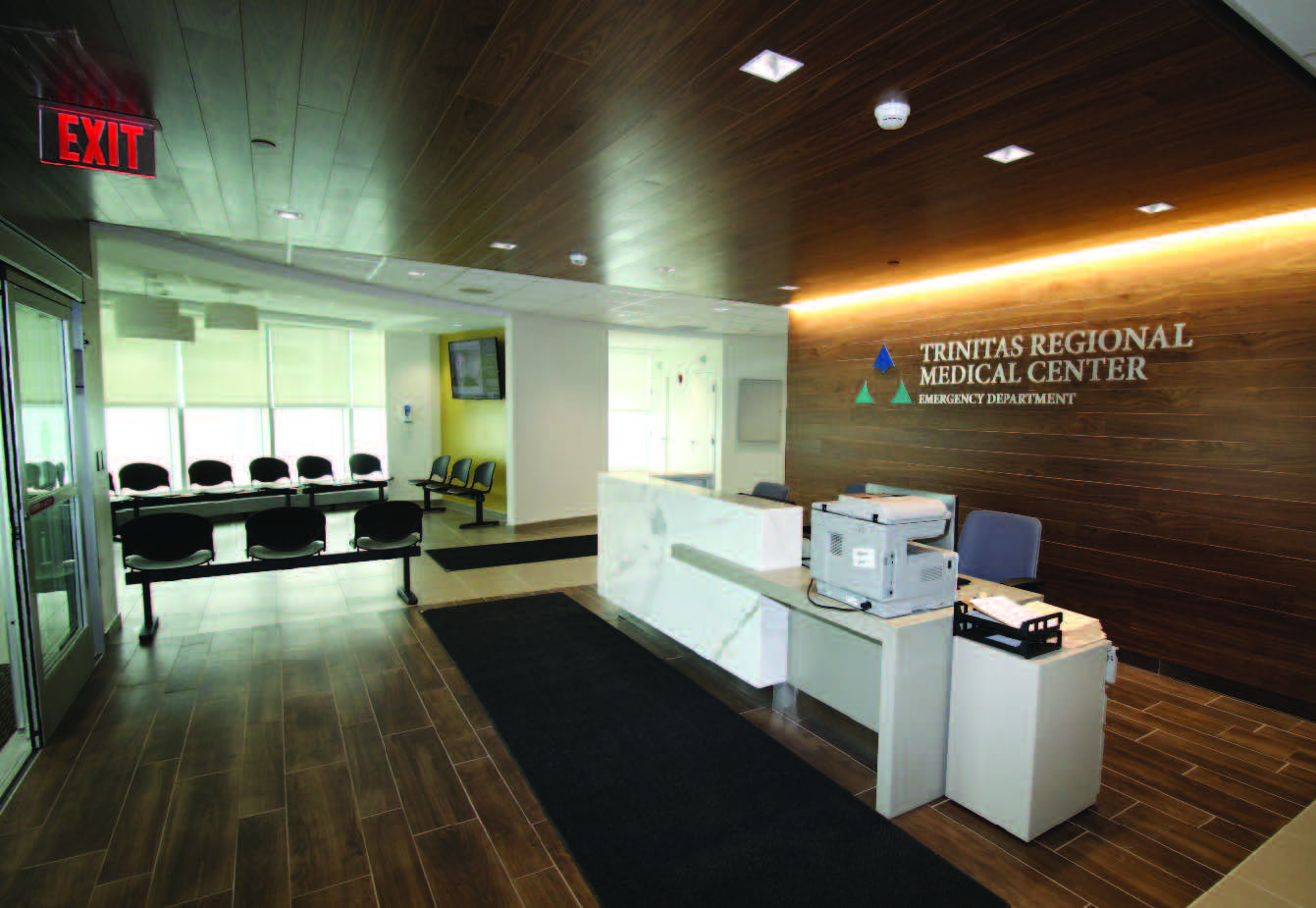Phases II and III of the hospital’s ER project are driven by emergency care…and emergency caring.
By Christine Gibbs
By this time next year, the ambitious $18.7 million expansion project for the Emergency Department at Trinitas Regional Medical Center will be long done. Phase I began in July of 2015 and ended in May of this year. Phase II is already nearing completion and the third and final phase is targeted for early 2017. Unlike most suburban hospitals, Trinitas is “land-locked” so there was not much real estate available for expansion. Even so, the architects and general contractor still managed to add 24,000 square feet, which will house 45 private spaces designed to accommodate emergency patients as soon as possible after coming through the front door.
The expansion itself was an absolute necessity. In the last few years, the number of patients seen annually in the Emergency Department was double the 35,000 it was originally designed for.
The Phase I improvements have already made a huge difference. They include three new treatment areas that provide 27 beds. The Fast Track area now has seven newly constructed treatment bays, the Behavioral Health area has six, and the Geriatric Unit has five new private rooms. There will also be an ICU accommodation comprised of three new rooms, as well as one renovated room. Once expansion is completed, 18 more treatment spaces will be added to the current 27 beds, which get the final number up to the aforementioned 45 spaces.
As with all projects of this nature, there have been some tweaks along the way. For example, the original plans for Phase II called for a two-story atrium waiting lounge. However, it was decided that the space would be more efficiently utilized by creating a second floor for the department’s administrative offices. The waiting room is now a single story, but with an entire wall of glass to bring some of the outside in. Additional improvements include a Radiology Suite, an Ultrasound Suite, and an Emergency Services Lounge for the staff.
What do the people who run the Emergency Department have to say about its progress? We sat down with Dr. John D’Angelo, Chairman of Emergency Medicine, Dr. Abie Li, Assistant Medical Director of Emergency Medicine and Mercy Mallari, RN, MSN ER Director…
What is the most valuable resource added as a result of the expansion program?
Dr. Li: The new CT scanner, for sure, since it benefits doctors and patients alike.
Dr. D’Angelo: I agree about the value of the scanner. Of course, the most valuable ER resource is the dedicated staff—those strong people who work to save lives every day are our most precious resource.
Were there any issues that gave you some sleepless nights during Phase I?
Dr. D’Angelo: Absolutely none [laughs]. The main issue during construction has revolved around spatial challenges—that is, how to keep the patient flow unhampered despite ongoing major construction activities.
Nurse Mallari: The ER never shuts down…the show must always go on!
Dr. D’Angelo: We actually experienced volume growth during Phase I, yet the “walk-out” rate went down. It was amazing that we were able to maintain the same level of performance and deliver the same quality of services despite some unavoidable inconveniences.
What can we expect from Phase III?
Nurse Mallari: Phase III will provide an ambitious “face lift” for all existing spaces with the goal of transforming the entire ER into a harmonious and homogenous environment.
Dr. D’Angelo: The effort to achieve this has involved careful planning and execution to make the ER as comfortable, healthy, and safe as possible for patients and visitors alike. This requires the full-blown expertise of both the design consultant firm we hired for the entire project, Ewing Cole, as well as the main construction company, Barr & Barr.
Once everything is done, how will Trinitas rate as an ER facility?
Dr. D’Angelo: To be fair, we should compare our ER with similar sized facilities in comparable urban areas that process at least 70,000 patients per year. In this group, Trinitas’ ER is ranked among the best. Our metrics—from time of arrival, to point of contact with provider, to final discharge—place us at the top of the industry. We also have a very low rate of patients who leave without being seen [see “Trinitas by the Numbers”]. Of course, the greater the volume, the greater the challenge to service all patients. I am determined as the Emergency Medicine Chairman to right-size the department so that we can handle the daily projected volume of patients.
When Phase III is done, how will you feel?
Dr. Li: Proud!
Nurse Mallari: Excited to serve the community…to show them that we are here to serve them.
Dr. D’Angelo: I feel especially proud of the geriatric area, which is becoming more important with the aging of the Baby Boomers. Geriatric care is a very resource-intense operation. Specific treatment is dependent upon the complexity of care needed by an older patient. Also, a lot of consideration must be given to proper aftercare. The majority of elderly patients are going to need to take advantage of our advanced technology, such as our new CT scanner and hand-held point-of-care bloodwork equipment that delivers lab results in 20 minutes, instead of 90. All architectural and construction planning for the project will reflect the latest advances to assure the physical safety of geriatrics while in our care. With the growing number of memory care patients, training will be given to staff on up-to-date testing procedures to assess levels of Alzheimer’s and dementia impairment in order to recommend the best final disposition of each patient from the ER.
Why did each of you choose Emergency Medicine as your specialty?
Dr. Li: I wanted to help as many of the sick as possible. The ER provides a “Spice of Life” environment with a constant flow of a wide variety of people who are in need of all kinds of help. I promised my parents I would try to help as many people as possible. In the ER, I can do that.
Nurse Mallari: Nursing has a wide array of specialties. During the rotation phase of my career, I felt an immediate calling during the ER training. The adrenaline surge from seeing a gunshot wound being treated right before my eyes to save a life was amazing. I felt, “This is home!”
Dr. D’Angelo: My reason for selecting Emergency Medicine has evolved over time. Somehow, I relate to how frenetic the energy in the Emergency Department can be. It takes a special breed of ER providers to be able to react quickly enough to resuscitate and save a sick child, or a parent, or a grandparent. We’re glad to be here and we’re looking forward to building an even stronger relationship with the entire community. We care for those who often times are marginalized in society and have no choice about where and who should provide them with healthcare. We are here for them. Our doors are always open.

John D’Angelo, DO Chairman/Emergency Medicine Trinitas Regional Medical Center

Abie Li, MD
Assistant Medical Director, Emergency Medicine
Trinitas Regional Medical Center

Mercy Mallari, RN, MSN ER Director
Trinitas Regional Medical Center





